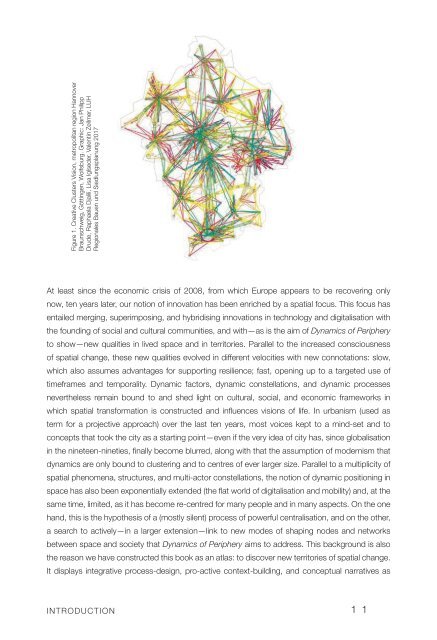Dynamics of Periphery
978-3-86859-511-6 https://www.jovis.de/de/buecher/vorschau/product/dynamics_of_periphery.html
978-3-86859-511-6
https://www.jovis.de/de/buecher/vorschau/product/dynamics_of_periphery.html
Create successful ePaper yourself
Turn your PDF publications into a flip-book with our unique Google optimized e-Paper software.
Figure 1. Creative Clusters Vision, metropolitan region Hannover<br />
Braunschweig, Göttingen, Wolfsburg. Graphic: Jan Philipp<br />
Drude, Raphaela Djalili, Lisa Iglseder, Valentin Zellmer, LUH<br />
Regionales Bauen und Siedlungsplanung 2017<br />
At least since the economic crisis <strong>of</strong> 2008, from which Europe appears to be recovering only<br />
now, ten years later, our notion <strong>of</strong> innovation has been enriched by a spatial focus. This focus has<br />
entailed merging, superimposing, and hybridising innovations in technology and digitalisation with<br />
the founding <strong>of</strong> social and cultural communities, and with—as is the aim <strong>of</strong> <strong>Dynamics</strong> <strong>of</strong> <strong>Periphery</strong><br />
to show—new qualities in lived space and in territories. Parallel to the increased consciousness<br />
<strong>of</strong> spatial change, these new qualities evolved in different velocities with new connotations: slow,<br />
which also assumes advantages for supporting resilience; fast, opening up to a targeted use <strong>of</strong><br />
timeframes and temporality. Dynamic factors, dynamic constellations, and dynamic processes<br />
nevertheless remain bound to and shed light on cultural, social, and economic frameworks in<br />
which spatial transformation is constructed and influences visions <strong>of</strong> life. In urbanism (used as<br />
term for a projective approach) over the last ten years, most voices kept to a mind-set and to<br />
concepts that took the city as a starting point—even if the very idea <strong>of</strong> city has, since globalisation<br />
in the nineteen-nineties, finally become blurred, along with that the assumption <strong>of</strong> modernism that<br />
dynamics are only bound to clustering and to centres <strong>of</strong> ever larger size. Parallel to a multiplicity <strong>of</strong><br />
spatial phenomena, structures, and multi-actor constellations, the notion <strong>of</strong> dynamic positioning in<br />
space has also been exponentially extended (the flat world <strong>of</strong> digitalisation and mobility) and, at the<br />
same time, limited, as it has become re-centred for many people and in many aspects. On the one<br />
hand, this is the hypothesis <strong>of</strong> a (mostly silent) process <strong>of</strong> powerful centralisation, and on the other,<br />
a search to actively—in a larger extension—link to new modes <strong>of</strong> shaping nodes and networks<br />
between space and society that <strong>Dynamics</strong> <strong>of</strong> <strong>Periphery</strong> aims to address. This background is also<br />
the reason we have constructed this book as an atlas: to discover new territories <strong>of</strong> spatial change.<br />
It displays integrative process-design, pro-active context-building, and conceptual narratives as<br />
INTRODUCTION<br />
11


















